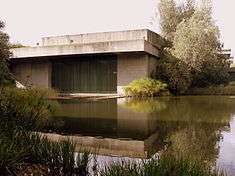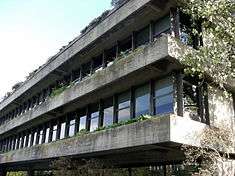Calouste Gulbenkian Museum
| Calouste Gulbenkian Museum (Museu Calouste Gulbenkian) | |
| Modern Art Centre | |
| Museum (Museu) | |
 A view of the Gulbenkian Museum and reflecting pool | |
| Official name: Sede e Museu da Fundação Calouste Gulbenkian/Centro de Arte Moderna | |
| Named for: Calouste Gulbenkian | |
| Country | |
|---|---|
| Region | Lisbon |
| Subregion | Greater Lisbon |
| District | Lisbon |
| Municipality | Lisbon |
| Location | Avenidas Novas |
| - coordinates | PT 38°44′12″N 9°9′15″W / 38.73667°N 9.15417°WCoordinates: PT 38°44′12″N 9°9′15″W / 38.73667°N 9.15417°W |
| Architects | Alberto Pessoa, Artur Rosa, Pedro Cid, Ruy Jervis d'Athouguia, Sir John Leslie Martin, Yvor Richards |
| Materials | Reinforced concrete, Limestone, Wood, Wrought and cast iron |
| Origin | April 1957 |
| - Completion | 1968 |
| Owner | Portuguese Republic |
| For public | Public |
| Easiest access | Avenida de Berna; Rua Dr. Nicolau Bettencourt |
| Management | Instituto Gestão do Patrimonio Arquitectónico e Arqueológico |
| Operator | Calouste Gulbenkian Foundation |
| Status | National Monument |
| Listing | Special Protection Zone, Decree 18/2010; Diário da República, Série-1, 250, 28 December 2010 |
 Location of the museum within the municipality of Lisbon
| |
| Wikimedia Commons: Calouste Gulbenkian Museum Exhibits | |
| Website: http://gulbenkian.pt/museu/en/ | |
The Calouste Gulbenkian Museum (Portuguese: Museu Calouste Gulbenkian) is a Portuguese museum in the civil parish of Avenidas Novas, in the municipality of Lisbon. Founded in conformity with Calouste Gulbenkian's last will and testament, the museum accommodates the art collection of the similarly-named Foundation, that includes ancient and, some, modern art.
History


Vasco Maria Eugénio de Almeida acquired part of the Parque de Santa Gertrudes, on April 1957, for the construction of the Foundation buildings and public/private park. Two years later, a competition was launched for a project to construct the organization's headquarters.[1] It was eventually won by the team that included architects Alberto J. Pessoa, Pedro Cid and Ruy Jervis d'Athouguia (1917-2006), in addition to the landscaping architects António Viana Barreto and Gonçalo Ribeiro Telles, who were responsible for designing the park surrounding the building.[1][2]Later, Francisco Caetano Keil do Amaral was added to the team, as a consultant, and Frederico Henrique George joined the team working on the building.[1][2]
In December 1961, the anterior project of the park was begun, while work on the earthworks and retaining walls beginning the following year.[1] A sculpture panel was installed in the headquarters building by architect Artur Rosa in 1962.[1] By 1967, the interior finishing were adjudicated, with the project concluded in 1968. On 2 October 1969, the buildings and gardens were inaugurated.[1]
The 12th International Federation of Landscaping Architects Congress was held in September 1970 on the grounds of the Gulbenkian Foundation. In 1975, the property was distinguished with the Valmor Prize.[1][2]
In 1983, the Modern Art Centre was constructed following the project of architect John Leslie Martin, while in 1985, a children's' pavilion was constructed under the guidance of architect John Leslie Martin and Yvor Richards.[1]
On 22 April 2002, the Vice-President of the IPPAR issued a dispatch to begin the administrative process for the eventual classification of the parque, main building, Modern Art Centre and gardens as national heritage.[1] Work on remodeling the park began in 2003, following the plan established by Gonçalo Ribeiro Telles.[1] On 7 June 2006, there was a dispatch by the Minister of Culture supporting the classification of the buildings. On 23 September 2008, the work on improving the interior air quality and energy conservation resulted in the building being classified as a Edifício Saudável (Healthy Building).[1]
In March 2015, it was announced that Penelope Curtis, director of Tate Britain from 2010 to 2015, would become the next director of Museu Calouste Gulbenkian.[3]
Architecture
.jpg)
The group of buildings is integrated into a walled space, delimited by the Avenida de Berna (north), Avenida António Augusto de Aguiar (west), Rua Marquês de Sá da Bandeira (east) and the Centro de Arte Moderna (south), and adapted to the natural terrain, behind a curtain of trees for protection.[1]
The design of the museum and headquarters is relatively simple, and includes two wings in a "T"-shaped format, with different entranceways, but accessible through the temporary exhibits, shrewdly situated in the museum and library connection.[2] The massive volume, long and horizontal was used for administration, services and as auditoriums, off of the main, single entry space.[2] It is in this entranceway that the panel Começar, by Almada Negreiros is situated.[2]
Collection

.jpg)
The permanent exhibition and galleries are distributed chronologically and in geographical order to create two independent circuits within the overall tour.
The first circuit highlights Greco-Roman art from classical antiquity, as well as art from the ancient Near East and the Nile Valley. Among the artworks are ancient Egyptian, Mesopotamian, Persian,[4] and Armenian pieces, as well as Persian art from the Islamic period.
The second circuit includes European art, with sections dedicated to the art of the book, sculpture, painting and the decorative arts, particularly 18th century French art and the work of René Lalique. In this circuit, a wide-ranging number of pieces reflect various European artistic trends from the beginning of the 11th century to the mid-20th century. The section begins with works in ivory and illuminated manuscript books, followed by a selection of 15th, 16th and 17th century sculptures and paintings. Renaissance art produced in the Netherlands, Flanders, France and Italy is on display in the next room. French 18th century decorative art has a special place in the museum, with outstanding gold and silver objects and furniture, as well as paintings and sculptures. This section is followed by galleries exhibiting a large group of paintings by the Venetian Francesco Guardi, 18th and 19th century English paintings, and finally a superb collection of jewels and glass by René Lalique, displayed in its own room.
Some of the works in the collection were bought during the Soviet sale of Hermitage paintings. Of about 6000 items in the museum's collections, a selection of around 1000 is on permanent exhibition. Gulbenkian's motto was "only the best"; hence the museum has masterpieces by western European artists such as Domenico Ghirlandaio, Rubens, Rembrandt, Rodin, Carpeaux, Houdon, Renoir, Dierick Bouts, Vittore Carpaccio, Cima da Conegliano, Van Dyck, Corot, Degas, Nattier, George Romney, Stefan Lochner, Maurice-Quentin de La Tour, Édouard Manet, Henri Fantin-Latour, Claude Monet, Jean-François Millet, Sir Edward Burne-Jones, Thomas Gainsborough, Joseph Mallord William Turner, Jean-Honoré Fragonard, Giovanni Battista Moroni, Frans Hals, Ruisdael, Boucher, Largillière, Andrea della Robbia, Pisanello, Jean-Baptiste Pigalle, Antonio Rossellino, André-Charles Boulle, Charles Cressent, Oeben, Riesener, Antoine-Sébastien Durand, Charles Spire, Jean Deforges, François-Thomas Germain.
References
Notes
- 1 2 3 4 5 6 7 8 9 10 11 12 Bandeira, Filomena (1998), SIPA, ed., Sede e Museu da Fundação Calouste Gulbenkian / Centro de Arte Moderna (IPA.00007810/PT031106230480) (in Portuguese), Lisbon, Portugal: SIPA – Sistema de Informação para o Património Arquitectónico, retrieved 16 February 2016
- 1 2 3 4 5 6 IGESPAR, ed. (2010), Edifício-Sede e Parque da Fundação Calouste Gulbenkian (in Portuguese), Lisbon, Portugal: IGESPAR - Instituto de Gestão do Património Arquitectónico e Arqueológico, retrieved 16 February 2016
- ↑ Ellis-Petersen, Hannah (31 March 2015). "Tate Britain director Penelope Curtis to step down after five years in charge". The Guardian. Retrieved 22 June 2015.
- ↑ Fundação Calouste Gulbenkian (1972)
Sources
- Correia, Graça (2013), Ruy D'Athouguia (in Portuguese), Aveleda, Portugal: Verso da História
- Guia de Arquitectura (in Portuguese), Lisbon, Portugal, 1994
- Leite, Ana Cristina (1988), Arquitectura Premiada em Lisboa. Prémio Valmor - Prémio Municipal de Arquitectura (in Portuguese), Lisbon, Portugal: Câmara Municipal de Lisboa
- Pedreirinho, José Manuel (1994), Dicionário de arquitectos activos em Portugal do Séc. I à actualidade (in Portuguese), Porto, Portugal: Edições Afrontamento
- PDM - Plano Director Municipal (in Portuguese), Lisbon, Portugal: Câmara Municipal de Lisboa, 1995
- Relatório da Actividade do Ministério no Ano de 1961 (in Portuguese), 2, Lisbon, Portugal: Ministério das Obras Públicas, 1962
- Sede da Fundação Gulbenkian declarada Edifício Saudável (in Portuguese) (98, November-December), Lisbon, Portugal: Fundação Calouste Gulbenkian, 2008
- Tostões, Ana (1997), Os Verdes Anos na Arquitectura Portuguesa dos Anos 50 (in Portuguese), Porto, Portugal: Faculdade de Arquitetura da Universidade do Porto
- Fundação Calouste Gulbenkian, ed. (1972), Persian Art: Calouste Gulbenkian Collection, Lisbon, Portugal: Fundação Calouste Gulbenkian